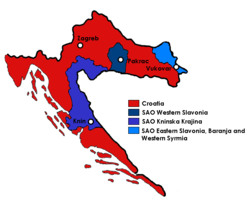|
SAO Krajina
The Serbian Autonomous Oblast of Krajina (Serbo-Croatian: Srpska autonomna oblast Krajina / Српска аутономна област Крајина) or SAO Krajina (САО Крајина) was a self-proclaimed Serb Autonomous Region (oblast) within modern-day Croatia (then a part of Yugoslavia). The territory consisted of majority-Serbian municipalities of the Republic of Croatia that declared autonomy in October 1990. It was formed as the SAO Kninska Krajina (САО Книнска Крајина), but, upon inclusion of additional Serb-populated areas, changed its name simply to SAO Krajina. In 1991 the SAO Krajina declared itself the Republic of Serbian Krajina, and subsequently included the other two Serbian SAOs in Croatia, the SAO Western Slavonia and the SAO Eastern Slavonia, Baranja and Western Syrmia. HistoryIn 1990, following Croatian multi-party elections and victory of the Croatian Democratic Union (HDZ), ethnic tensions between Croats and Serbs worsened.[2] On 17 August 1990, an insurrection began in areas of the Republic of Croatia which were populated significantly by ethnic Serbs.[3] The organizers were armed with illegal weapons supplied by Milan Martić.[3] The revolt was explained by Serbs as the result of them being "terrorized [by Croatian government]" and that they wanted to "[fight for] more cultural, language and education rights". Serbian newspaper "Večernje Novosti" wrote that "2.000.000 Serbs [are] ready to go to Croatia to fight". Western diplomats criticized Serbian media for "inflaming passions" while Croatian President Franjo Tudjman stated that "We knew about the scenario to create confusion in Croatia...".[4] In anticipation of a declaration of Croatian independence, Croatian Serb leaders created an autonomous region around the city of Knin. The Serbian National Council (SNV) was formed, functioning as a parliament for the region and as the ultimate authority on Croatian Serbs. It organized a successful referendum on autonomy in August.[5][6] Initially, this region was dubbed the SAO Kninska Krajina in September 1990,[7] but, after joining with the Association of Municipalities of Northern Dalmatia and Lika, it was renamed and proclaimed as SAO Krajina in December 1990.[5] By October, the Serb National Council proclaimed it autonomous.[7] It encompassed Krajina as well as three Northern Dalmatian municipalities with an ethnic Serb majority (Benkovac, Knin and Obrovac).[5] On December 21, 1990, the municipalities of Knin, Benkovac, Vojnić, Obrovac, Gračac, Dvor and Kostajnica all adopted the "Statute of the Serbian Autonomous Region of Krajina".[8] On February 28, 1991 the SAO Krajina was officially declared.[7] It announced that it planned to separate from Croatia if it moved for independence from Yugoslavia. The Serb National Council on March 16, 1991 declared Krajina to be independent of Croatia. On May 12, 1991 a referendum was held with over 99 percent of the vote supporting unification with Serbia.[1] On 1 April 1991, it declared that it would secede from Croatia.[9] Afterwards the Krajina assembly declared that "the territory of the SAO Krajina is a constitutive part of the unified territory of the Republic of Serbia".[1] Conflict soon began between the Krajina Serbs and Croatian authorities. After Slovenia and Croatia declared independence, violence escalated as the Serbs expanded the territory they held with the help of the Yugoslav People's Army (JNA), eventually to include SAO Eastern Slavonia, Baranja and Western Syrmia and SAO Western Slavonia. On 19 December 1991, the two SAOs through the initiative of Milan Babić (president of SAO Krajina) and Goran Hadžić (president of SAO Eastern Slavonia, Baranja and Western Syrmia) were declared as one Serbian state with the name Republic of Serbian Krajina. In February 1992, the authorities declared independence. By that time, Serb-controlled territory included a third of Croatia.[10] This self-proclaimed SAO Krajina was dissolved after August 5, 1995 when Croatian armed forces reintegrated its territories into Croatia. See also
References
External links |
||||||||||||||||||||||||||||||||||||||||||
Portal di Ensiklopedia Dunia


